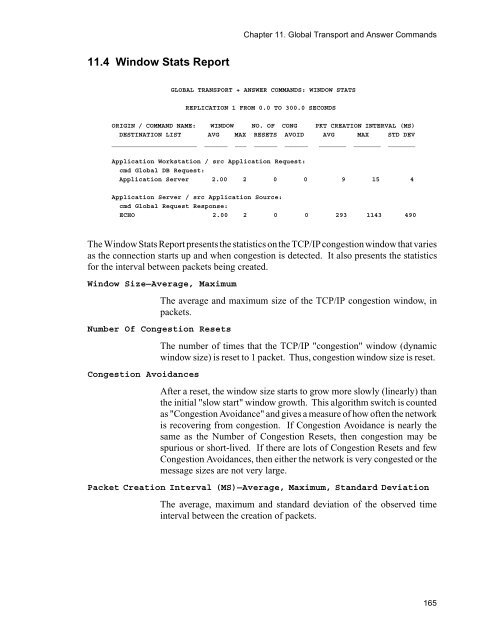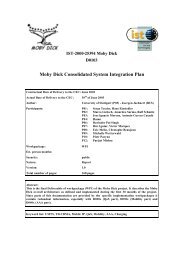COMNET III
COMNET III
COMNET III
Create successful ePaper yourself
Turn your PDF publications into a flip-book with our unique Google optimized e-Paper software.
Chapter 11. Global Transport and Answer Commands<br />
11.4 Window Stats Report<br />
GLOBAL TRANSPORT + ANSWER COMMANDS: WINDOW STATS<br />
REPLICATION 1 FROM 0.0 TO 300.0 SECONDS<br />
ORIGIN / COMMAND NAME: WINDOW NO. OF CONG PKT CREATION INTERVAL (MS)<br />
DESTINATION LIST AVG MAX RESETS AVOID AVG MAX STD DEV<br />
______________________ ______ ___ ______ ______ _______ _______ _______<br />
Application Workstation / src Application Request:<br />
cmd Global DB Request:<br />
Application Server 2.00 2 0 0 9 15 4<br />
Application Server / src Application Source:<br />
cmd Global Request Response:<br />
ECHO 2.00 2 0 0 293 1143 490<br />
The Window Stats Report presents the statistics on the TCP/IP congestion window that varies<br />
as the connection starts up and when congestion is detected. It also presents the statistics<br />
for the interval between packets being created.<br />
Window Size—Average, Maximum<br />
The average and maximum size of the TCP/IP congestion window, in<br />
packets.<br />
Number Of Congestion Resets<br />
Congestion Avoidances<br />
The number of times that the TCP/IP "congestion" window (dynamic<br />
window size) is reset to 1 packet. Thus, congestion window size is reset.<br />
After a reset, the window size starts to grow more slowly (linearly) than<br />
the initial "slow start" window growth. This algorithm switch is counted<br />
as "Congestion Avoidance" and gives a measure of how often the network<br />
is recovering from congestion. If Congestion Avoidance is nearly the<br />
same as the Number of Congestion Resets, then congestion may be<br />
spurious or short-lived. If there are lots of Congestion Resets and few<br />
Congestion Avoidances, then either the network is very congested or the<br />
message sizes are not very large.<br />
Packet Creation Interval (MS)—Average, Maximum, Standard Deviation<br />
The average, maximum and standard deviation of the observed time<br />
interval between the creation of packets.<br />
165
















